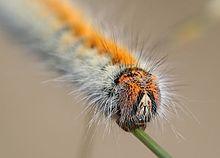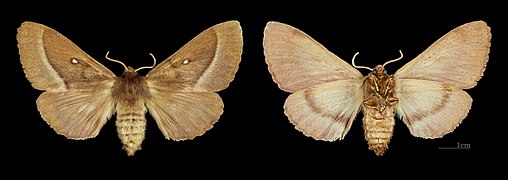Clover moth
| Clover moth | ||||||||||||
|---|---|---|---|---|---|---|---|---|---|---|---|---|

Moth clover ( Lasiocampa trifolii ) |
||||||||||||
| Systematics | ||||||||||||
|
||||||||||||
| Scientific name | ||||||||||||
| Lasiocampa trifolii | ||||||||||||
| ( Denis & Schiffermüller , 1775) |
The Clover Spinner ( Lasiocampa trifolii ) is a butterfly ( moth ) from the family of clucking (Lasiocampidae).
features
The moths reach a wingspan of 34 to 67 millimeters. The males have a reddish or gray-brown wing base color. A white, dark-edged discoidal spot and a slightly S-shaped curved yellowish band can be seen on the forewings, which runs approximately between the second and third third of the wing. The females have the same basic wing color, but their yellowish band is usually weak or dark in color.
The caterpillars are about 75 millimeters long. They are dark gray in color, but because of their very thick and long, white, ocher or orange hair, you can hardly see them. The rings between the segments are clearly dark in color, with three longitudinal rows of bluish white dots being drawn there. There are also very dark caterpillars with only white hair or almost completely gray animals. Her head is russet with black and yellow markings on the front.
Subspecies
- Lasiocampa trifolii cocles (Geyer, 1831)
- Lasiocampa trifolii trifolii (Denis & Schiffermüller, 1775)
Similar species
- Oak moth ( Lasiocampa quercus )
Occurrence
The animals occur all over Europe except the far north and the north of Great Britain , east to Iran . They live in dry, grassy areas, such as B. on dry grass and pastures. They are also rarely found on wet meadows . They are widespread and sometimes common, but are declining in populations in most areas .
Way of life
Flight and caterpillar times
The adults fly in one generation from late July to early September, the caterpillars are found in May and June, or from late October and early November.
Food of the caterpillars
The caterpillars feed on many different low-growing plants, but prefer butterflies (Faboideae) such as B. Spiny Restharrow ( Ononis spinosa ), white clover ( Trifolium repens ) seeds sainfoin ( Onobrychis viciifolia ), Lathyrus pratensis ( Lathyrus pratensis ), Sickle alfalfa ( Medicago falcata ) and Broom ( Sarothamnus scoparius ), but also eat heather ( Calluna vulgaris ) and numerous grasses such as B. Pipe grass ( Molinia caerulea ).
development
The females shed their brown or gray, spotty eggs in flight over meadows. Some of the caterpillars hatch in autumn and after wintering in the next spring. The caterpillars are solitary and live well hidden in the dense meadow vegetation. However, you can occasionally see them basking high on blades of grass, resting their heads down. They are very shy and immediately fall curled up if they are alarmed. At first they only feed on grasses, only later do they also eat the other plants mentioned above. They have stinging hairs that can be painful to touch. They pupate in a sturdy, parchment-like, brown-yellow, barrel-shaped cocoon , close to the ground.
swell
Individual evidence
- ↑ a b c d e Heiko Bellmann : The new cosmos butterfly guide. Butterflies, caterpillars and forage plants. Franckh-Kosmos, Stuttgart 2003, ISBN 3-440-09330-1 , p. 78.
- ↑ a b c d Hans-Josef Weidemann, Jochen Köhler: Moth. Weirdos and hawkers. Naturbuch-Verlag, Augsburg 1996, ISBN 3-89440-128-1 , p. 100ff.
- ↑ a b Lasiocampa (Pachygastria) trifolii (Denis & Schiffermüller 1775). Fauna Europaea, Version 1.3, April 19, 2007 , accessed on December 26, 2007 .
- ↑ Lasiocampa trifolii. Butterflies-Deutschlands.de, Christian Tolasch, accessed on November 2, 2006 .
literature
- Günter Ebert (Ed.): The Butterflies of Baden-Württemberg Volume 4, Moths II (Bombycidae, Endromidae, Lasiocampidae, Lemoniidae)
- Manfred Koch , Wolfgang Heinicke: We identify butterflies. 3. Edition. Neumann, Radebeul 1991, ISBN 3-7402-0092-8 .





